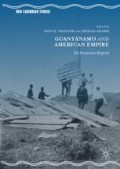Abstract
This chapter addresses visual representations of the U.S. naval base at Guantánamo in relation to the idea of home. The visual art it considers presents a cultural site rather than a political and legal one; a borderland where the naval base and eastern Cuba are united both territorially and creatively; and a space of complex conceptual geographies, where Cuba, the Caribbean, the U.S., the Middle East, and Europe converge. Works by photographer Edmund Clark from his series Guantánamo: If the Lights Go Out and ‘El camino de la estrategia,’ a multimedia project by Cuban artists Alexander Beatón and Pedro Gutiérrez, among other visual representations, counter the geographic abstraction and rhetorical hostility that have characterized the base with an exploration of how ‘home’ can take shape.
Bibliography
Adelman, Rebecca. “Safe, Humane, Legal, Transparent: State Visions of Guantánamo Bay.” Reconstruction 12, no. 4 (2013). Accessed February 20, 2017. http://reconstruction.eserver.org/Issues/124/Adelman_Rebecca.shtml.
Azoulay, Ariella. The Civil Contract of Photography. New York: Zone Books, 2008.
Beatón, Alexander, and Pedro Gutiérrez. “Proyecto artístico: El camino de la estrategia.” Guantánamo: UNEAC, 2009–2011.
Butler, Judith. Precarious Life: The Powers of Mourning and Violence. London: Verso, 2004.
Castro, Fidel. “Discurso efectuado en la Plaza de la Revolución ‘Mariana Grajales,’ en Guantánamo, el 16 de abril de 1994, Año 36 de la Revolución.” In A escasos metros del enemigo: Historia de la Brigada de la Frontera, edited by Felipa Suárez and Pilar Quesada, 202–7. La Habana: Ediciones Verde Olivo, 1996.
Castro, Raúl. “Discurso pronunciado en las conclusiones de la primera sesión ordinaria de la VII Legislatura de la Asamblea Nacional del Poder Popular. Palacio de las Convenciones, La Habana, 11 de julio de 2008.” Discursos e intervenciones del Presidente de los Consejos de Estado y de Ministros de la República de Cuba General de Ejército Raúl Castro Ruz. Accessed February 20, 2017. http://www.cuba.cu/gobierno/rauldiscursos/2008/esp/r110708e.html.
Cedeño, Reinaldo. “Cerca de Guantánamo Bay.” El mar y la montaña 1 (Junio 2009): 24–25.
Clark, Edmund. Guantánamo: If the Light Goes Out. Stockport, UK: Dewi Lewis Publishing, 2011.
Cornwall, Debi. Welcome to Camp America. Santa Fe, N.M: Radius Books, 2017.
Cruz, Oscar. “Guantánamo escrito.” La noria 7 (2014), 23.
Dopico, Ana María. “Picturing Havana: History, Vision and the Scramble for Cuba.” Nepantla: Views from South 3, no. 3 (2002): 451–93.
Erikson, Daniel P. The Cuba Wars: Fidel Castro, the United States, and the Next Revolution. New York: Bloomsbury Press, 2009.
Greenberg, Karen. The Least Worst Place: Guantanamo’s First 100 Days. New York: Oxford University Press, 2009.
Hamlin, Janet. Sketching Guantanamo: Court Sketches of the Military Tribunals, 2006–2013. Seattle: Fantagraphics, 2013.
Kaplan, Amy. “Where Is Guantánamo?” American Quarterly 57, no. 3 (September 2005): 831–58.
Linhardt, Christina, and Michael L. Rose, dirs. Guantánamo Circus, 2013. Screened at the Feinstein Center of the University of Rhode Island, Providence, September 11, 2014. http://www.imdb.com/title/tt2760174/.
Lipman, Jana K. Guantánamo: A Working Class History Between Empire and Revolution. Berkeley: University of California Press, 2009.
Marrero, Meira, Loring McAlpin, and José Toirac. In God We Trust: America’s Most Wanted. Havana: La Casona Galería de Arte, 2009.
Musashi, Miyamoto. The Complete Book of Five Rings. Translated by Kenji Tokitsu. Boston: Shambhala, [c.1645] 2012.
Ortega, Julio. Translations of poems by Usama Abu Kabir, Imad Abdullah Hassan and Siddiq Turkestani. La noria 7 (2014): 2–4.
Pinter, Harold. “Art, Truth, Politics.” Nobel Prize for Literature Acceptance Speech, 2005. Accessed February 20, 2017. http://www.nobelprize.org/nobel_prizes/literature/laureates/2005/pinter-lecture-e.html.
Redfield, Marc. The Rhetoric of Terror: Reflections on 9/11 and the War on Terror. New York: Fordham University Press, 2009.
Reuters. “Cuba: The Sun Sets on a Commuter Era.” The New York Times, December 31, 2012: A9.
Sánchez Leyva, José Ramón. “Los quilos,” “La nariz ganchuda del semita,” and “Imposible.” La noria 7 (2014): 61–64.
Suárez, Felipa, and Pilar Quesada. A escasos metros del enemigo: Historia de la Brigada de la Frontera. La Habana: Ediciones Verde Olivo, 1996.
Whitfield, Esther. “Cuban Borderlands: Local Stories of the Guantánamo Naval Base.” MLN 130, no. 2 (2015): 276–97.
Author information
Authors and Affiliations
Corresponding author
Editor information
Editors and Affiliations
Rights and permissions
Copyright information
© 2017 The Author(s)
About this chapter
Cite this chapter
Whitfield, E. (2017). Guantánamo and Community: Visual Approaches to the Naval Base. In: Walicek, D.E., Adams, J. (eds) Guantánamo and American Empire. New Caribbean Studies. Palgrave Macmillan, Cham. https://doi.org/10.1007/978-3-319-62268-2_6
Download citation
DOI: https://doi.org/10.1007/978-3-319-62268-2_6
Published:
Publisher Name: Palgrave Macmillan, Cham
Print ISBN: 978-3-319-62267-5
Online ISBN: 978-3-319-62268-2
eBook Packages: Literature, Cultural and Media StudiesLiterature, Cultural and Media Studies (R0)

